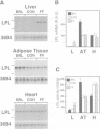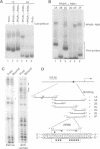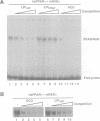Abstract
Increased activity of lipoprotein lipase (LPL) may explain the hypotriglyceridemic effects of fibrates, thiazolidinediones and fatty acids, which are known activators (and/or ligands) of the various peroxisome proliferator-activated receptors (PPARs). Treatment with compounds which activate preferentially PPARalpha, such as fenofibrate, induced LPL expression exclusively in rat liver. In contrast, the antidiabetic thiazolidinedione BRL 49653, a high affinity ligand for PPARgamma, had no effect on liver, but induced LPL expression in rat adipose tissue. In the hepatocyte cell line AML-12, fenofibric acid, but not BRL 49653, induced LPL mRNA, whereas in 3T3-L1 preadipocytes, the PPARgamma ligand induced LPL mRNA levels much quicker and to a higher extent than fenofibric acid. In both the in vivo and in vitro studies, inducibility by either PPARalpha or gamma activators, correlated with the tissue distribution of the respective PPARs: an adipocyte-restricted expression of PPARgamma, whereas PPARalpha was expressed predominantly in liver. A sequence element was identified in the human LPL promoter that mediates the functional responsiveness to fibrates and thiazolidinediones. Methylation interference and gel retardation assays demonstrated that a PPARalpha or gamma and the 9-cis retinoic acid receptor (RXR) heterodimers bind to this sequence -169 TGCCCTTTCCCCC -157. These data provide evidence that transcriptional activation of the LPL gene by fibrates and thiazolidinediones is mediated by PPAR-RXR heterodimers and contributes significantly to their hypotriglyceridemic effects in vivo. Whereas thiazolidinediones predominantly affect adipocyte LPL production through activation of PPARgamma, fibrates exert their effects mainly in the liver via activation of PPARalpha.
Full text
PDF
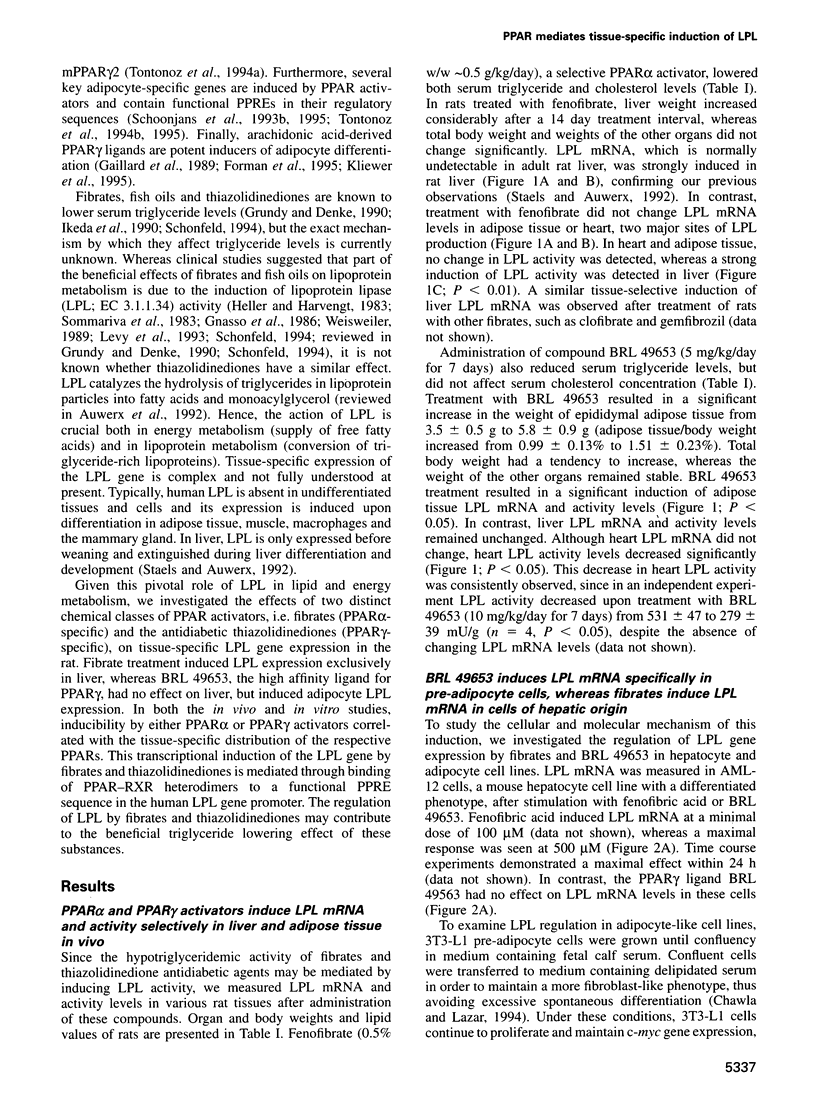
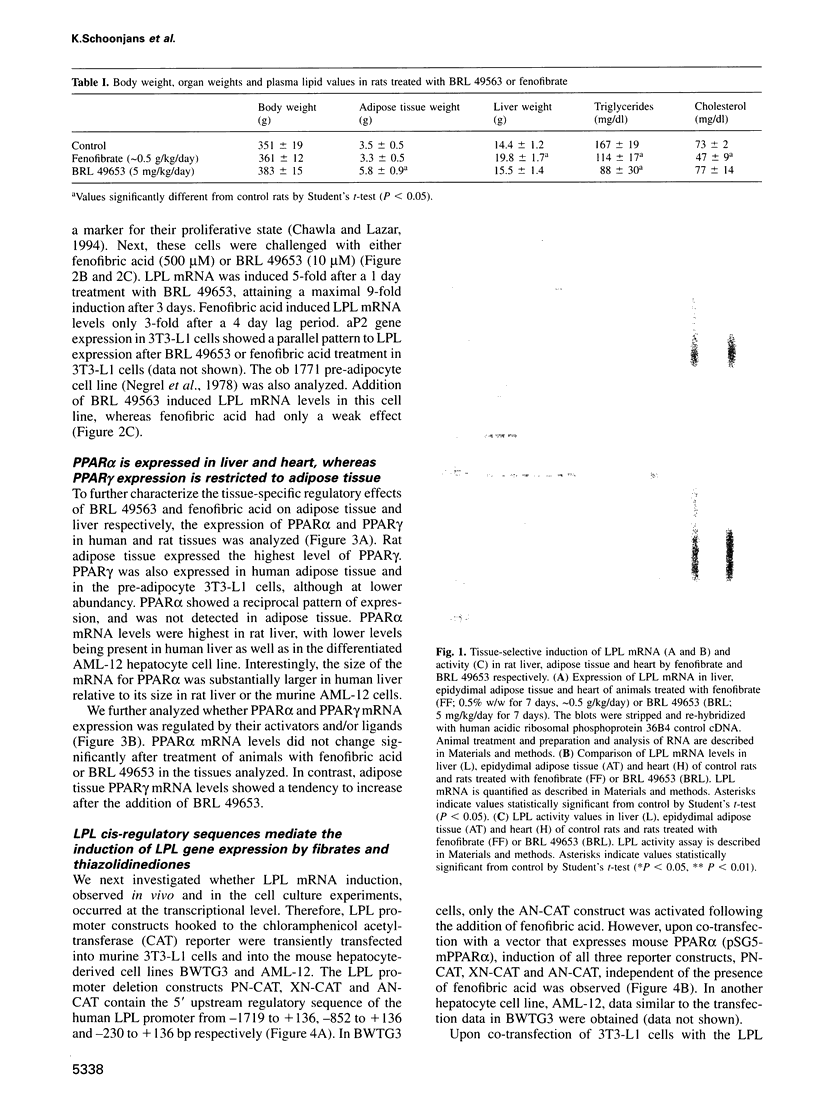
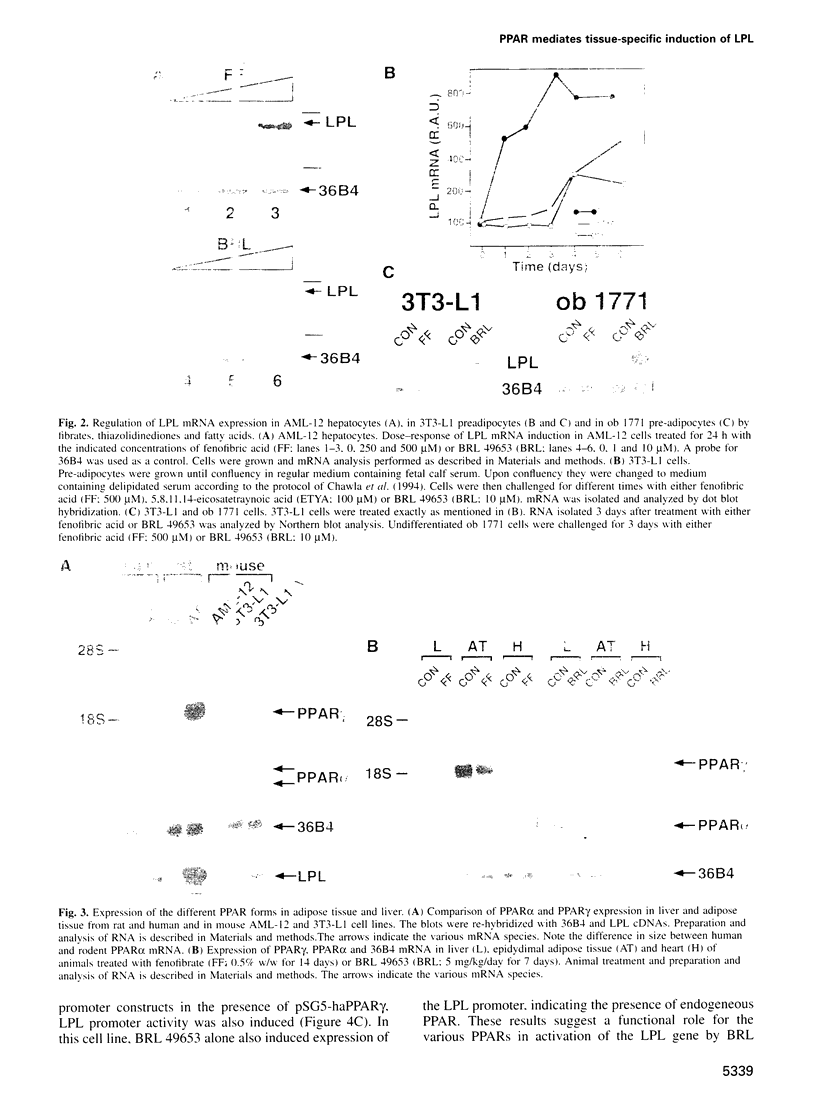
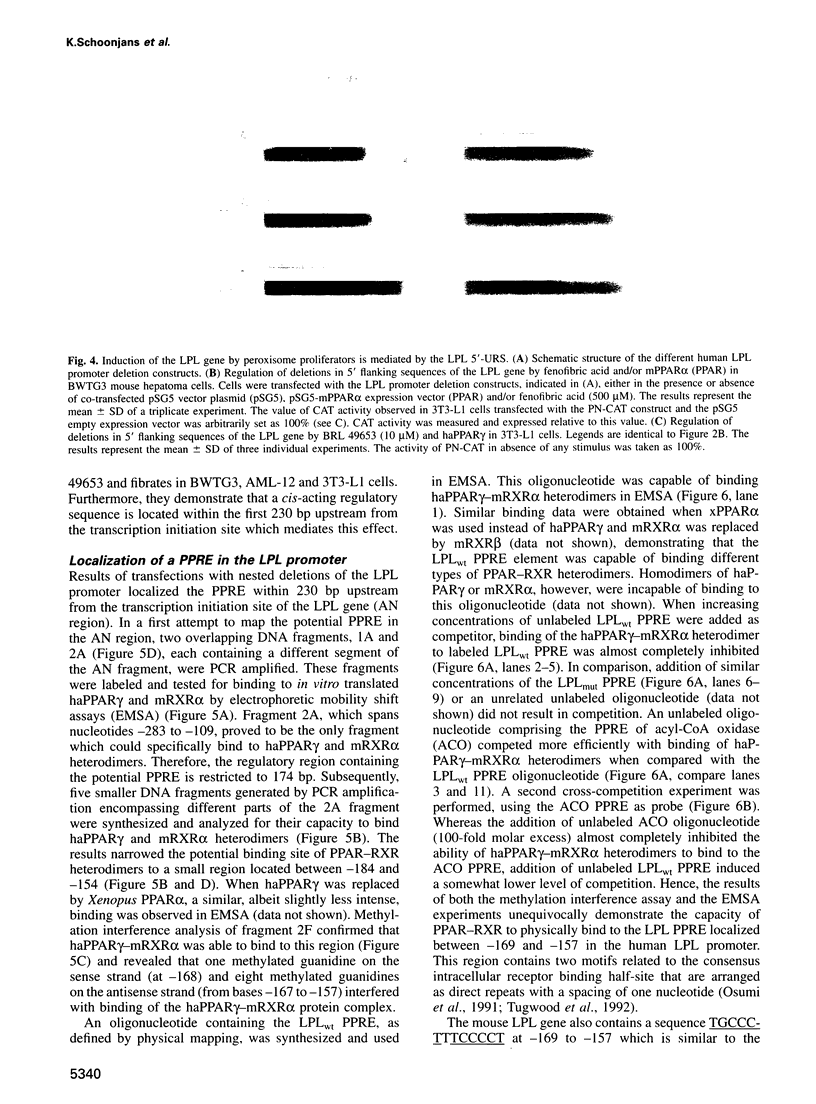
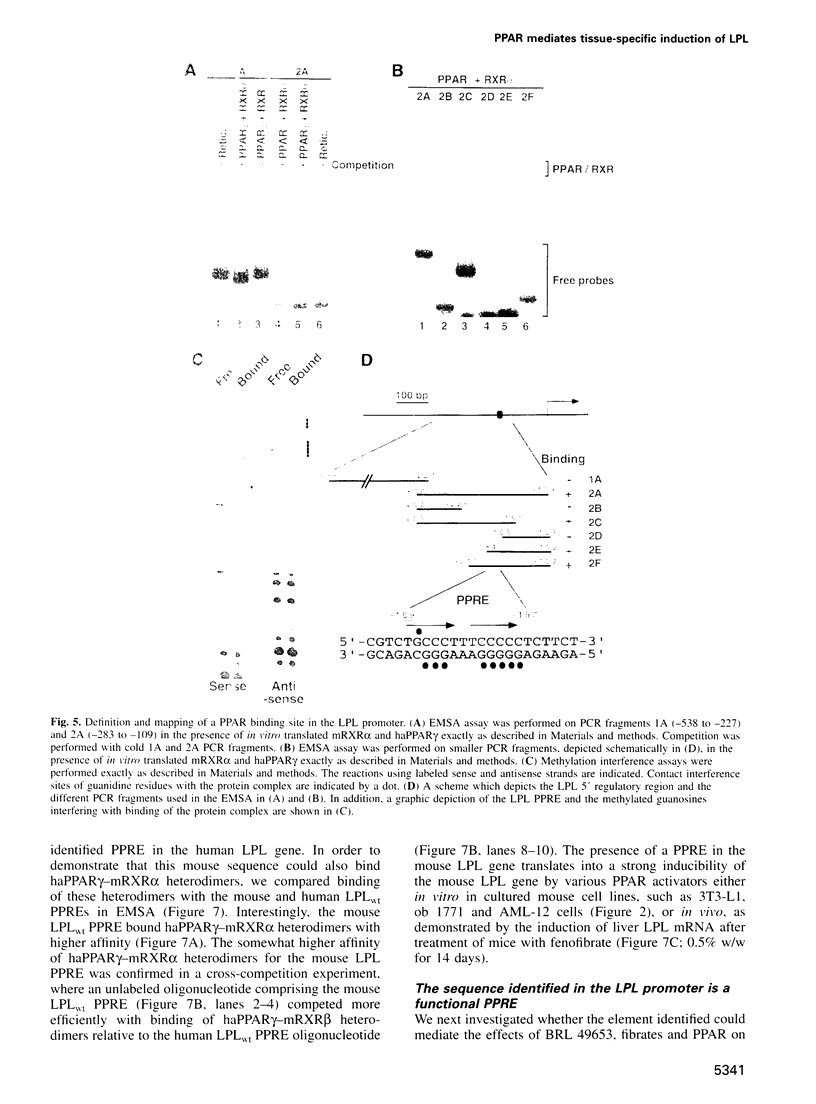
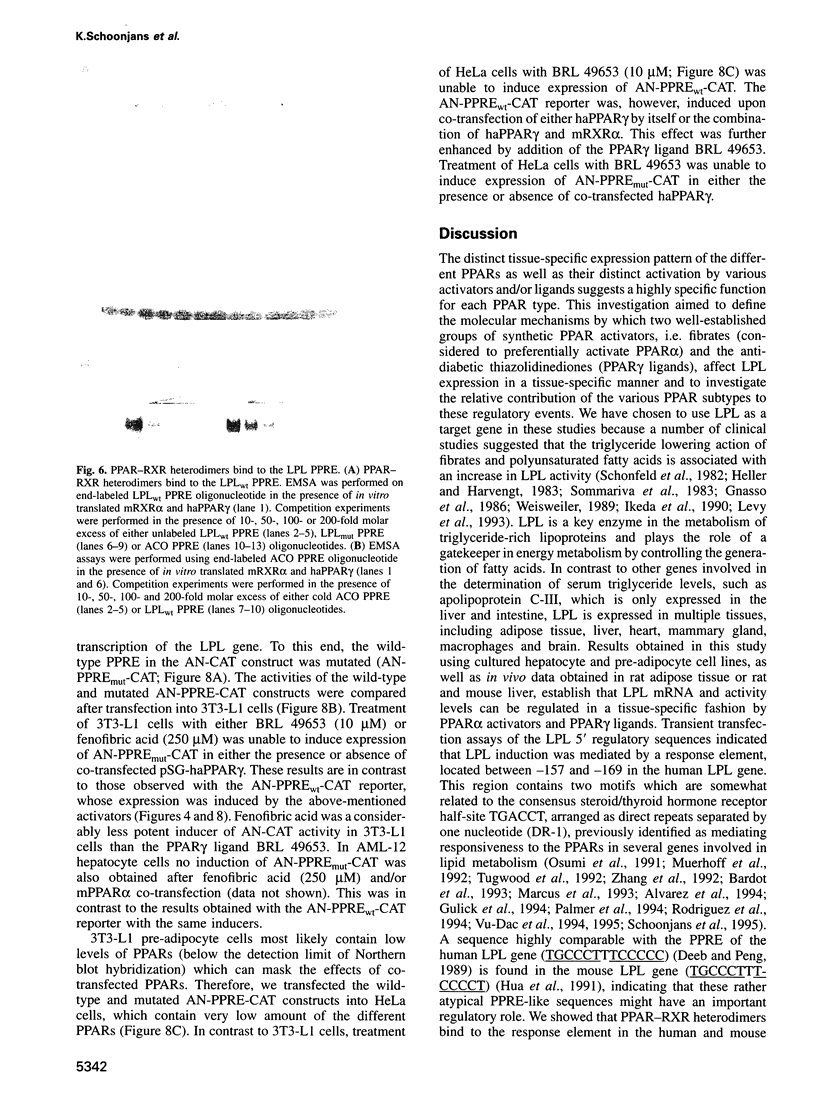
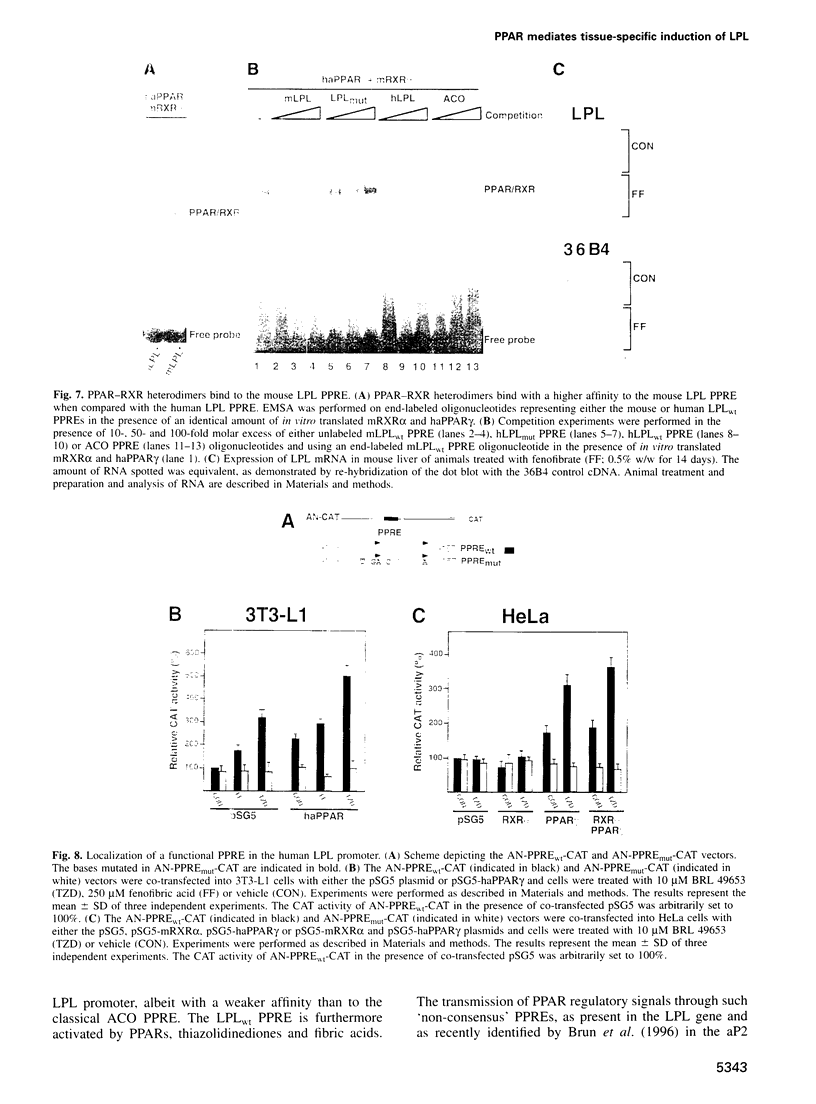
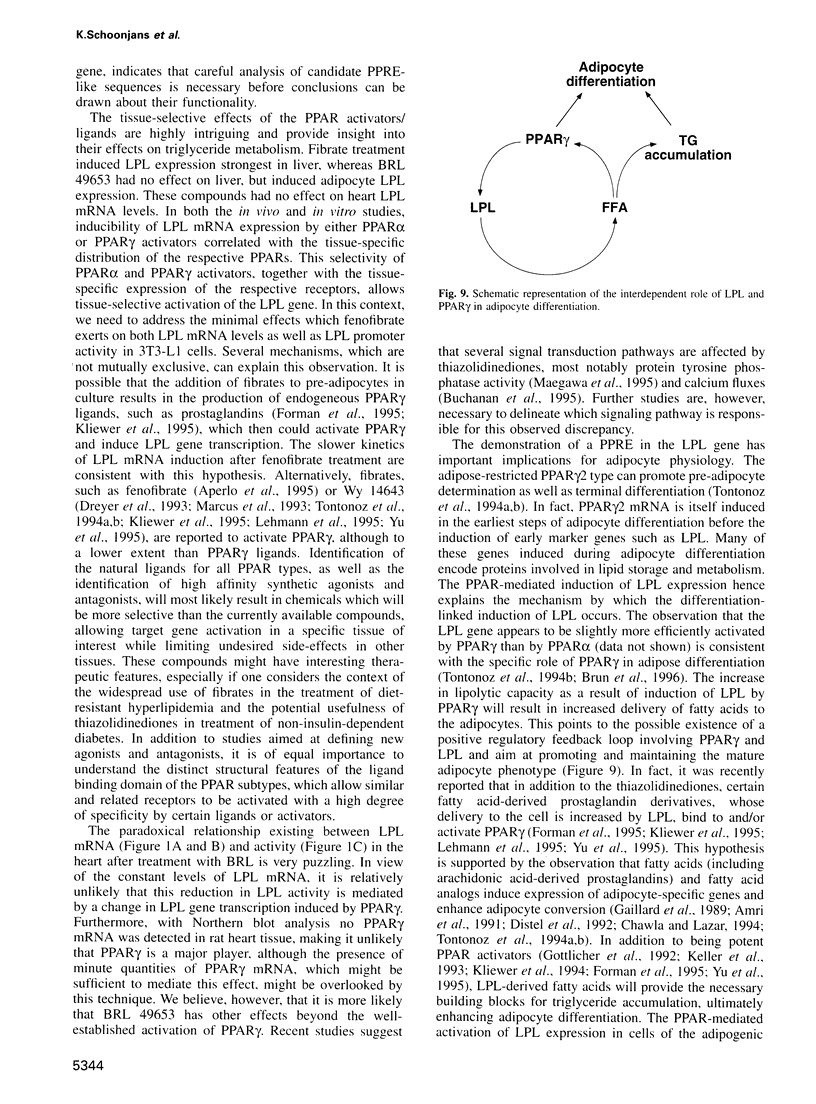
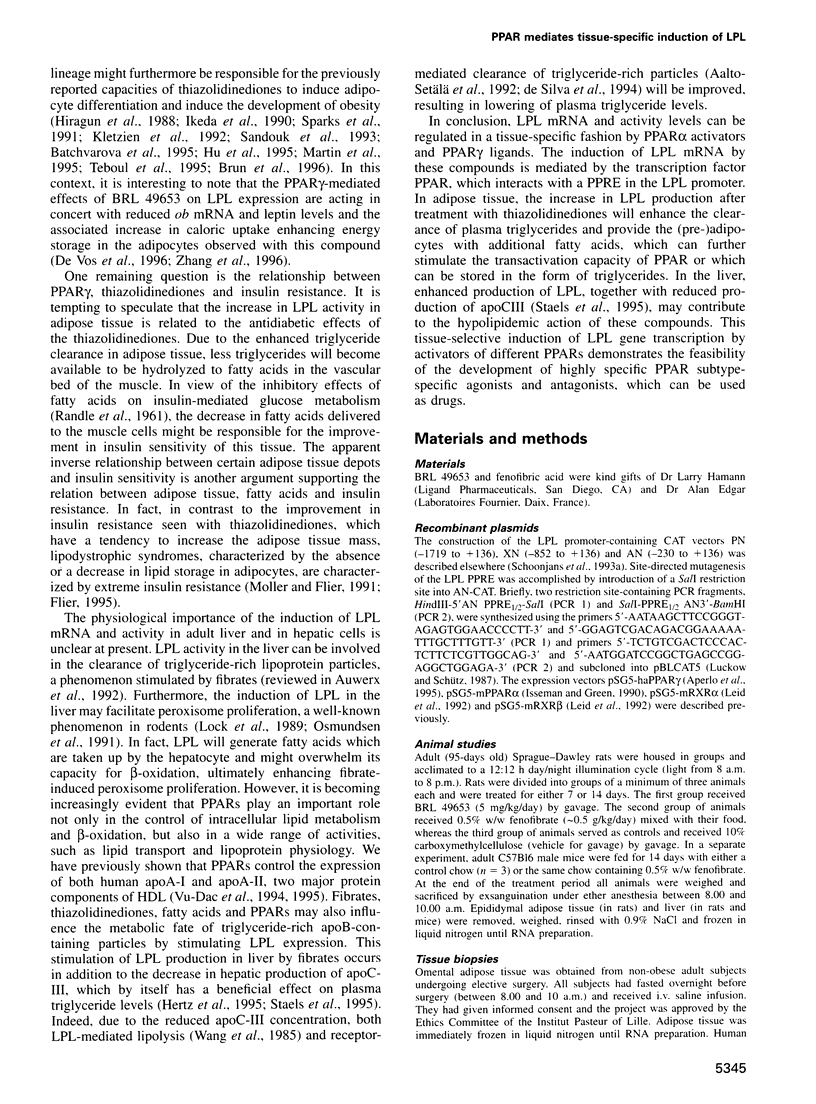
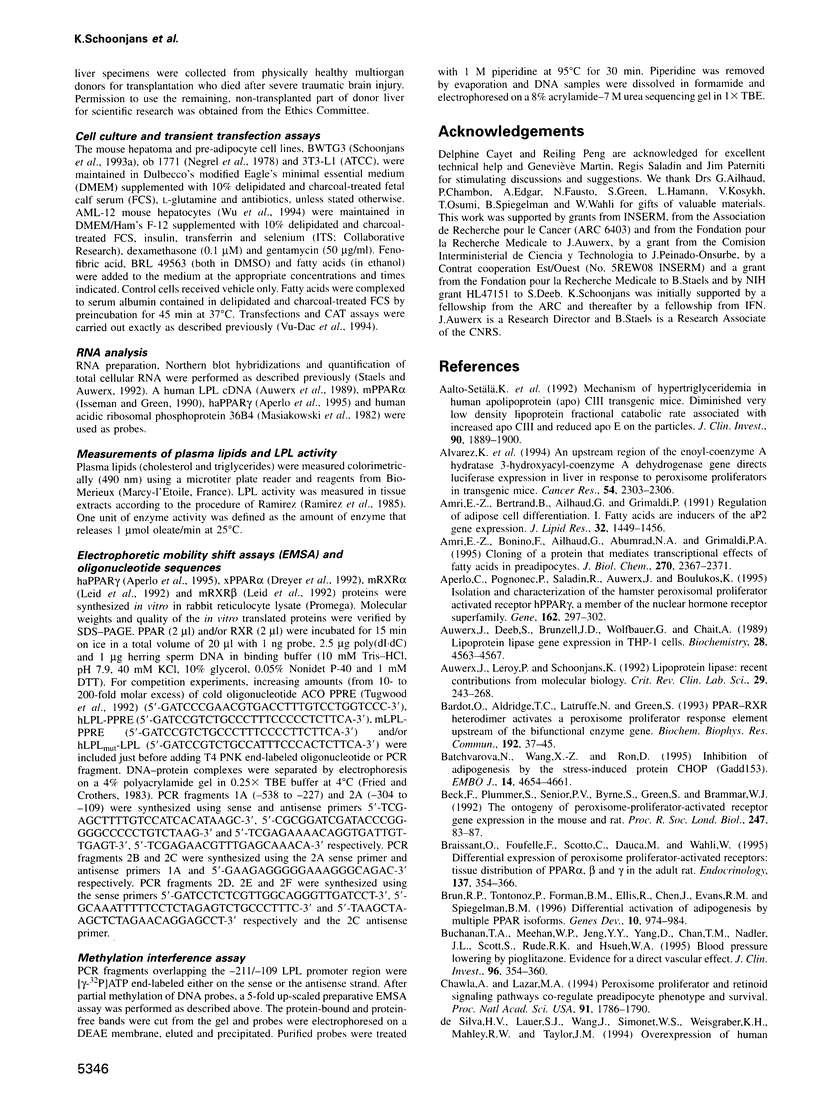


Images in this article
Selected References
These references are in PubMed. This may not be the complete list of references from this article.
- Aalto-Setälä K., Fisher E. A., Chen X., Chajek-Shaul T., Hayek T., Zechner R., Walsh A., Ramakrishnan R., Ginsberg H. N., Breslow J. L. Mechanism of hypertriglyceridemia in human apolipoprotein (apo) CIII transgenic mice. Diminished very low density lipoprotein fractional catabolic rate associated with increased apo CIII and reduced apo E on the particles. J Clin Invest. 1992 Nov;90(5):1889–1900. doi: 10.1172/JCI116066. [DOI] [PMC free article] [PubMed] [Google Scholar]
- Amri E. Z., Bertrand B., Ailhaud G., Grimaldi P. Regulation of adipose cell differentiation. I. Fatty acids are inducers of the aP2 gene expression. J Lipid Res. 1991 Sep;32(9):1449–1456. [PubMed] [Google Scholar]
- Amri E. Z., Bonino F., Ailhaud G., Abumrad N. A., Grimaldi P. A. Cloning of a protein that mediates transcriptional effects of fatty acids in preadipocytes. Homology to peroxisome proliferator-activated receptors. J Biol Chem. 1995 Feb 3;270(5):2367–2371. doi: 10.1074/jbc.270.5.2367. [DOI] [PubMed] [Google Scholar]
- Aperlo C., Pognonec P., Saladin R., Auwerx J., Boulukos K. E. cDNA cloning and characterization of the transcriptional activities of the hamster peroxisome proliferator-activated receptor haPPAR gamma. Gene. 1995 Sep 11;162(2):297–302. doi: 10.1016/0378-1119(95)00196-d. [DOI] [PubMed] [Google Scholar]
- Auwerx J. H., Deeb S., Brunzell J. D., Wolfbauer G., Chait A. Lipoprotein lipase gene expression in THP-1 cells. Biochemistry. 1989 May 30;28(11):4563–4567. doi: 10.1021/bi00437a009. [DOI] [PubMed] [Google Scholar]
- Auwerx J., Leroy P., Schoonjans K. Lipoprotein lipase: recent contributions from molecular biology. Crit Rev Clin Lab Sci. 1992;29(3-4):243–268. doi: 10.3109/10408369209114602. [DOI] [PubMed] [Google Scholar]
- Bardot O., Aldridge T. C., Latruffe N., Green S. PPAR-RXR heterodimer activates a peroxisome proliferator response element upstream of the bifunctional enzyme gene. Biochem Biophys Res Commun. 1993 Apr 15;192(1):37–45. doi: 10.1006/bbrc.1993.1378. [DOI] [PubMed] [Google Scholar]
- Batchvarova N., Wang X. Z., Ron D. Inhibition of adipogenesis by the stress-induced protein CHOP (Gadd153). EMBO J. 1995 Oct 2;14(19):4654–4661. doi: 10.1002/j.1460-2075.1995.tb00147.x. [DOI] [PMC free article] [PubMed] [Google Scholar]
- Beck F., Plummer S., Senior P. V., Byrne S., Green S., Brammar W. J. The ontogeny of peroxisome-proliferator-activated receptor gene expression in the mouse and rat. Proc Biol Sci. 1992 Feb 22;247(1319):83–87. doi: 10.1098/rspb.1992.0012. [DOI] [PubMed] [Google Scholar]
- Braissant O., Foufelle F., Scotto C., Dauça M., Wahli W. Differential expression of peroxisome proliferator-activated receptors (PPARs): tissue distribution of PPAR-alpha, -beta, and -gamma in the adult rat. Endocrinology. 1996 Jan;137(1):354–366. doi: 10.1210/endo.137.1.8536636. [DOI] [PubMed] [Google Scholar]
- Brun R. P., Tontonoz P., Forman B. M., Ellis R., Chen J., Evans R. M., Spiegelman B. M. Differential activation of adipogenesis by multiple PPAR isoforms. Genes Dev. 1996 Apr 15;10(8):974–984. doi: 10.1101/gad.10.8.974. [DOI] [PubMed] [Google Scholar]
- Buchanan T. A., Meehan W. P., Jeng Y. Y., Yang D., Chan T. M., Nadler J. L., Scott S., Rude R. K., Hsueh W. A. Blood pressure lowering by pioglitazone. Evidence for a direct vascular effect. J Clin Invest. 1995 Jul;96(1):354–360. doi: 10.1172/JCI118041. [DOI] [PMC free article] [PubMed] [Google Scholar]
- Chawla A., Lazar M. A. Peroxisome proliferator and retinoid signaling pathways co-regulate preadipocyte phenotype and survival. Proc Natl Acad Sci U S A. 1994 Mar 1;91(5):1786–1790. doi: 10.1073/pnas.91.5.1786. [DOI] [PMC free article] [PubMed] [Google Scholar]
- Deeb S. S., Peng R. L. Structure of the human lipoprotein lipase gene. Biochemistry. 1989 May 16;28(10):4131–4135. doi: 10.1021/bi00436a001. [DOI] [PubMed] [Google Scholar]
- Distel R. J., Robinson G. S., Spiegelman B. M. Fatty acid regulation of gene expression. Transcriptional and post-transcriptional mechanisms. J Biol Chem. 1992 Mar 25;267(9):5937–5941. [PubMed] [Google Scholar]
- Dreyer C., Krey G., Keller H., Givel F., Helftenbein G., Wahli W. Control of the peroxisomal beta-oxidation pathway by a novel family of nuclear hormone receptors. Cell. 1992 Mar 6;68(5):879–887. doi: 10.1016/0092-8674(92)90031-7. [DOI] [PubMed] [Google Scholar]
- Forman B. M., Tontonoz P., Chen J., Brun R. P., Spiegelman B. M., Evans R. M. 15-Deoxy-delta 12, 14-prostaglandin J2 is a ligand for the adipocyte determination factor PPAR gamma. Cell. 1995 Dec 1;83(5):803–812. doi: 10.1016/0092-8674(95)90193-0. [DOI] [PubMed] [Google Scholar]
- Fried M. G., Crothers D. M. CAP and RNA polymerase interactions with the lac promoter: binding stoichiometry and long range effects. Nucleic Acids Res. 1983 Jan 11;11(1):141–158. doi: 10.1093/nar/11.1.141. [DOI] [PMC free article] [PubMed] [Google Scholar]
- Gaillard D., Négrel R., Lagarde M., Ailhaud G. Requirement and role of arachidonic acid in the differentiation of pre-adipose cells. Biochem J. 1989 Jan 15;257(2):389–397. doi: 10.1042/bj2570389. [DOI] [PMC free article] [PubMed] [Google Scholar]
- Gnasso A., Lehner B., Haberbosch W., Leiss O., von Bergmann K., Augustin J. Effect of gemfibrozil on lipids, apoproteins, and postheparin lipolytic activities in normolipidemic subjects. Metabolism. 1986 May;35(5):387–393. doi: 10.1016/0026-0495(86)90125-3. [DOI] [PubMed] [Google Scholar]
- Grundy S. M., Denke M. A. Dietary influences on serum lipids and lipoproteins. J Lipid Res. 1990 Jul;31(7):1149–1172. [PubMed] [Google Scholar]
- Gulick T., Cresci S., Caira T., Moore D. D., Kelly D. P. The peroxisome proliferator-activated receptor regulates mitochondrial fatty acid oxidative enzyme gene expression. Proc Natl Acad Sci U S A. 1994 Nov 8;91(23):11012–11016. doi: 10.1073/pnas.91.23.11012. [DOI] [PMC free article] [PubMed] [Google Scholar]
- Göttlicher M., Widmark E., Li Q., Gustafsson J. A. Fatty acids activate a chimera of the clofibric acid-activated receptor and the glucocorticoid receptor. Proc Natl Acad Sci U S A. 1992 May 15;89(10):4653–4657. doi: 10.1073/pnas.89.10.4653. [DOI] [PMC free article] [PubMed] [Google Scholar]
- Heller F., Harvengt C. Effects of clofibrate, bezafibrate, fenofibrate and probucol on plasma lipolytic enzymes in normolipaemic subjects. Eur J Clin Pharmacol. 1983;25(1):57–63. doi: 10.1007/BF00544015. [DOI] [PubMed] [Google Scholar]
- Hertz R., Bishara-Shieban J., Bar-Tana J. Mode of action of peroxisome proliferators as hypolipidemic drugs. Suppression of apolipoprotein C-III. J Biol Chem. 1995 Jun 2;270(22):13470–13475. doi: 10.1074/jbc.270.22.13470. [DOI] [PubMed] [Google Scholar]
- Hiragun A., Sato M., Mitsui H. Preadipocyte differentiation in vitro: identification of a highly active adipogenic agent. J Cell Physiol. 1988 Jan;134(1):124–130. doi: 10.1002/jcp.1041340115. [DOI] [PubMed] [Google Scholar]
- Hu E., Tontonoz P., Spiegelman B. M. Transdifferentiation of myoblasts by the adipogenic transcription factors PPAR gamma and C/EBP alpha. Proc Natl Acad Sci U S A. 1995 Oct 10;92(21):9856–9860. doi: 10.1073/pnas.92.21.9856. [DOI] [PMC free article] [PubMed] [Google Scholar]
- Hua X. X., Enerbäck S., Hudson J., Youkhana K., Gimble J. M. Cloning and characterization of the promoter of the murine lipoprotein lipase-encoding gene: structural and functional analysis. Gene. 1991 Nov 15;107(2):247–258. doi: 10.1016/0378-1119(91)90325-6. [DOI] [PubMed] [Google Scholar]
- Ikeda H., Taketomi S., Sugiyama Y., Shimura Y., Sohda T., Meguro K., Fujita T. Effects of pioglitazone on glucose and lipid metabolism in normal and insulin resistant animals. Arzneimittelforschung. 1990 Feb;40(2 Pt 1):156–162. [PubMed] [Google Scholar]
- Issemann I., Green S. Activation of a member of the steroid hormone receptor superfamily by peroxisome proliferators. Nature. 1990 Oct 18;347(6294):645–650. doi: 10.1038/347645a0. [DOI] [PubMed] [Google Scholar]
- Keller H., Dreyer C., Medin J., Mahfoudi A., Ozato K., Wahli W. Fatty acids and retinoids control lipid metabolism through activation of peroxisome proliferator-activated receptor-retinoid X receptor heterodimers. Proc Natl Acad Sci U S A. 1993 Mar 15;90(6):2160–2164. doi: 10.1073/pnas.90.6.2160. [DOI] [PMC free article] [PubMed] [Google Scholar]
- Kletzien R. F., Clarke S. D., Ulrich R. G. Enhancement of adipocyte differentiation by an insulin-sensitizing agent. Mol Pharmacol. 1992 Feb;41(2):393–398. [PubMed] [Google Scholar]
- Kliewer S. A., Forman B. M., Blumberg B., Ong E. S., Borgmeyer U., Mangelsdorf D. J., Umesono K., Evans R. M. Differential expression and activation of a family of murine peroxisome proliferator-activated receptors. Proc Natl Acad Sci U S A. 1994 Jul 19;91(15):7355–7359. doi: 10.1073/pnas.91.15.7355. [DOI] [PMC free article] [PubMed] [Google Scholar]
- Kliewer S. A., Lenhard J. M., Willson T. M., Patel I., Morris D. C., Lehmann J. M. A prostaglandin J2 metabolite binds peroxisome proliferator-activated receptor gamma and promotes adipocyte differentiation. Cell. 1995 Dec 1;83(5):813–819. doi: 10.1016/0092-8674(95)90194-9. [DOI] [PubMed] [Google Scholar]
- Lehmann J. M., Moore L. B., Smith-Oliver T. A., Wilkison W. O., Willson T. M., Kliewer S. A. An antidiabetic thiazolidinedione is a high affinity ligand for peroxisome proliferator-activated receptor gamma (PPAR gamma). J Biol Chem. 1995 Jun 2;270(22):12953–12956. doi: 10.1074/jbc.270.22.12953. [DOI] [PubMed] [Google Scholar]
- Leid M., Kastner P., Lyons R., Nakshatri H., Saunders M., Zacharewski T., Chen J. Y., Staub A., Garnier J. M., Mader S. Purification, cloning, and RXR identity of the HeLa cell factor with which RAR or TR heterodimerizes to bind target sequences efficiently. Cell. 1992 Jan 24;68(2):377–395. doi: 10.1016/0092-8674(92)90478-u. [DOI] [PubMed] [Google Scholar]
- Levy E., Thibault L., Turgeon J., Roy C. C., Gurbindo C., Lepage G., Godard M., Rivard G. E., Seidman E. Beneficial effects of fish-oil supplements on lipids, lipoproteins, and lipoprotein lipase in patients with glycogen storage disease type I. Am J Clin Nutr. 1993 Jun;57(6):922–929. doi: 10.1093/ajcn/57.6.922. [DOI] [PubMed] [Google Scholar]
- Lock E. A., Mitchell A. M., Elcombe C. R. Biochemical mechanisms of induction of hepatic peroxisome proliferation. Annu Rev Pharmacol Toxicol. 1989;29:145–163. doi: 10.1146/annurev.pa.29.040189.001045. [DOI] [PubMed] [Google Scholar]
- Luckow B., Schütz G. CAT constructions with multiple unique restriction sites for the functional analysis of eukaryotic promoters and regulatory elements. Nucleic Acids Res. 1987 Jul 10;15(13):5490–5490. doi: 10.1093/nar/15.13.5490. [DOI] [PMC free article] [PubMed] [Google Scholar]
- Maegawa H., Ide R., Hasegawa M., Ugi S., Egawa K., Iwanishi M., Kikkawa R., Shigeta Y., Kashiwagi A. Thiazolidine derivatives ameliorate high glucose-induced insulin resistance via the normalization of protein-tyrosine phosphatase activities. J Biol Chem. 1995 Mar 31;270(13):7724–7730. doi: 10.1074/jbc.270.13.7724. [DOI] [PubMed] [Google Scholar]
- Marcus S. L., Miyata K. S., Zhang B., Subramani S., Rachubinski R. A., Capone J. P. Diverse peroxisome proliferator-activated receptors bind to the peroxisome proliferator-responsive elements of the rat hydratase/dehydrogenase and fatty acyl-CoA oxidase genes but differentially induce expression. Proc Natl Acad Sci U S A. 1993 Jun 15;90(12):5723–5727. doi: 10.1073/pnas.90.12.5723. [DOI] [PMC free article] [PubMed] [Google Scholar]
- Martin L. F., Hunter S. M., Lauve R. M., O'Leary J. P. Severe obesity: expensive to society, frustrating to treat, but important to confront. South Med J. 1995 Sep;88(9):895–902. doi: 10.1097/00007611-199509000-00001. [DOI] [PubMed] [Google Scholar]
- Masiakowski P., Breathnach R., Bloch J., Gannon F., Krust A., Chambon P. Cloning of cDNA sequences of hormone-regulated genes from the MCF-7 human breast cancer cell line. Nucleic Acids Res. 1982 Dec 20;10(24):7895–7903. doi: 10.1093/nar/10.24.7895. [DOI] [PMC free article] [PubMed] [Google Scholar]
- Moller D. E., Flier J. S. Insulin resistance--mechanisms, syndromes, and implications. N Engl J Med. 1991 Sep 26;325(13):938–948. doi: 10.1056/NEJM199109263251307. [DOI] [PubMed] [Google Scholar]
- Muerhoff A. S., Griffin K. J., Johnson E. F. The peroxisome proliferator-activated receptor mediates the induction of CYP4A6, a cytochrome P450 fatty acid omega-hydroxylase, by clofibric acid. J Biol Chem. 1992 Sep 25;267(27):19051–19053. [PubMed] [Google Scholar]
- Négrel R., Grimaldi P., Ailhaud G. Establishment of preadipocyte clonal line from epididymal fat pad of ob/ob mouse that responds to insulin and to lipolytic hormones. Proc Natl Acad Sci U S A. 1978 Dec;75(12):6054–6058. doi: 10.1073/pnas.75.12.6054. [DOI] [PMC free article] [PubMed] [Google Scholar]
- Osmundsen H., Bremer J., Pedersen J. I. Metabolic aspects of peroxisomal beta-oxidation. Biochim Biophys Acta. 1991 Sep 11;1085(2):141–158. doi: 10.1016/0005-2760(91)90089-z. [DOI] [PubMed] [Google Scholar]
- Osumi T., Wen J. K., Hashimoto T. Two cis-acting regulatory sequences in the peroxisome proliferator-responsive enhancer region of rat acyl-CoA oxidase gene. Biochem Biophys Res Commun. 1991 Mar 29;175(3):866–871. doi: 10.1016/0006-291x(91)91645-s. [DOI] [PubMed] [Google Scholar]
- Palmer C. N., Hsu M. H., Muerhoff A. S., Griffin K. J., Johnson E. F. Interaction of the peroxisome proliferator-activated receptor alpha with the retinoid X receptor alpha unmasks a cryptic peroxisome proliferator response element that overlaps an ARP-1-binding site in the CYP4A6 promoter. J Biol Chem. 1994 Jul 8;269(27):18083–18089. [PubMed] [Google Scholar]
- Ramírez I., Kryski A. J., Ben-Zeev O., Schotz M. C., Severson D. L. Characterization of triacylglycerol hydrolase activities in isolated myocardial cells from rat heart. Biochem J. 1985 Nov 15;232(1):229–236. doi: 10.1042/bj2320229. [DOI] [PMC free article] [PubMed] [Google Scholar]
- Rodríguez J. C., Gil-Gómez G., Hegardt F. G., Haro D. Peroxisome proliferator-activated receptor mediates induction of the mitochondrial 3-hydroxy-3-methylglutaryl-CoA synthase gene by fatty acids. J Biol Chem. 1994 Jul 22;269(29):18767–18772. [PubMed] [Google Scholar]
- Sandouk T., Reda D., Hofmann C. Antidiabetic agent pioglitazone enhances adipocyte differentiation of 3T3-F442A cells. Am J Physiol. 1993 Jun;264(6 Pt 1):C1600–C1608. doi: 10.1152/ajpcell.1993.264.6.C1600. [DOI] [PubMed] [Google Scholar]
- Schmidt A., Endo N., Rutledge S. J., Vogel R., Shinar D., Rodan G. A. Identification of a new member of the steroid hormone receptor superfamily that is activated by a peroxisome proliferator and fatty acids. Mol Endocrinol. 1992 Oct;6(10):1634–1641. doi: 10.1210/mend.6.10.1333051. [DOI] [PubMed] [Google Scholar]
- Schonfeld G., Patsch W., Rudel L. L., Nelson C., Epstein M., Olson R. E. Effects of dietary cholesterol and fatty acids on plasma lipoproteins. J Clin Invest. 1982 May;69(5):1072–1080. doi: 10.1172/JCI110542. [DOI] [PMC free article] [PubMed] [Google Scholar]
- Schonfeld G. The effects of fibrates on lipoprotein and hemostatic coronary risk factors. Atherosclerosis. 1994 Dec;111(2):161–174. doi: 10.1016/0021-9150(94)90090-6. [DOI] [PubMed] [Google Scholar]
- Schoonjans K., Staels B., Devos P., Szpirer J., Szpirer C., Deeb S., Verhoeven G., Auwerx J. Developmental extinction of liver lipoprotein lipase mRNA expression might be regulated by an NF-1-like site. FEBS Lett. 1993 Aug 23;329(1-2):89–95. doi: 10.1016/0014-5793(93)80200-e. [DOI] [PubMed] [Google Scholar]
- Schoonjans K., Staels B., Grimaldi P., Auwerx J. Acyl-CoA synthetase mRNA expression is controlled by fibric-acid derivatives, feeding and liver proliferation. Eur J Biochem. 1993 Sep 1;216(2):615–622. doi: 10.1111/j.1432-1033.1993.tb18181.x. [DOI] [PubMed] [Google Scholar]
- Schoonjans K., Watanabe M., Suzuki H., Mahfoudi A., Krey G., Wahli W., Grimaldi P., Staels B., Yamamoto T., Auwerx J. Induction of the acyl-coenzyme A synthetase gene by fibrates and fatty acids is mediated by a peroxisome proliferator response element in the C promoter. J Biol Chem. 1995 Aug 18;270(33):19269–19276. doi: 10.1074/jbc.270.33.19269. [DOI] [PubMed] [Google Scholar]
- Sher T., Yi H. F., McBride O. W., Gonzalez F. J. cDNA cloning, chromosomal mapping, and functional characterization of the human peroxisome proliferator activated receptor. Biochemistry. 1993 Jun 1;32(21):5598–5604. doi: 10.1021/bi00072a015. [DOI] [PubMed] [Google Scholar]
- Sparks R. L., Strauss E. E., Zygmunt A. I., Phelan T. E. Antidiabetic AD4743 enhances adipocyte differentiation of 3T3 T mesenchymal stem cells. J Cell Physiol. 1991 Jan;146(1):101–109. doi: 10.1002/jcp.1041460114. [DOI] [PubMed] [Google Scholar]
- Staels B., Auwerx J. Perturbation of developmental gene expression in rat liver by fibric acid derivatives: lipoprotein lipase and alpha-fetoprotein as models. Development. 1992 Aug;115(4):1035–1043. doi: 10.1242/dev.115.4.1035. [DOI] [PubMed] [Google Scholar]
- Staels B., Vu-Dac N., Kosykh V. A., Saladin R., Fruchart J. C., Dallongeville J., Auwerx J. Fibrates downregulate apolipoprotein C-III expression independent of induction of peroxisomal acyl coenzyme A oxidase. A potential mechanism for the hypolipidemic action of fibrates. J Clin Invest. 1995 Feb;95(2):705–712. doi: 10.1172/JCI117717. [DOI] [PMC free article] [PubMed] [Google Scholar]
- Teboul L., Gaillard D., Staccini L., Inadera H., Amri E. Z., Grimaldi P. A. Thiazolidinediones and fatty acids convert myogenic cells into adipose-like cells. J Biol Chem. 1995 Nov 24;270(47):28183–28187. doi: 10.1074/jbc.270.47.28183. [DOI] [PubMed] [Google Scholar]
- Tontonoz P., Hu E., Devine J., Beale E. G., Spiegelman B. M. PPAR gamma 2 regulates adipose expression of the phosphoenolpyruvate carboxykinase gene. Mol Cell Biol. 1995 Jan;15(1):351–357. doi: 10.1128/mcb.15.1.351. [DOI] [PMC free article] [PubMed] [Google Scholar]
- Tontonoz P., Hu E., Graves R. A., Budavari A. I., Spiegelman B. M. mPPAR gamma 2: tissue-specific regulator of an adipocyte enhancer. Genes Dev. 1994 May 15;8(10):1224–1234. doi: 10.1101/gad.8.10.1224. [DOI] [PubMed] [Google Scholar]
- Tontonoz P., Hu E., Spiegelman B. M. Stimulation of adipogenesis in fibroblasts by PPAR gamma 2, a lipid-activated transcription factor. Cell. 1994 Dec 30;79(7):1147–1156. doi: 10.1016/0092-8674(94)90006-x. [DOI] [PubMed] [Google Scholar]
- Tugwood J. D., Issemann I., Anderson R. G., Bundell K. R., McPheat W. L., Green S. The mouse peroxisome proliferator activated receptor recognizes a response element in the 5' flanking sequence of the rat acyl CoA oxidase gene. EMBO J. 1992 Feb;11(2):433–439. doi: 10.1002/j.1460-2075.1992.tb05072.x. [DOI] [PMC free article] [PubMed] [Google Scholar]
- Vu-Dac N., Schoonjans K., Kosykh V., Dallongeville J., Fruchart J. C., Staels B., Auwerx J. Fibrates increase human apolipoprotein A-II expression through activation of the peroxisome proliferator-activated receptor. J Clin Invest. 1995 Aug;96(2):741–750. doi: 10.1172/JCI118118. [DOI] [PMC free article] [PubMed] [Google Scholar]
- Vu-Dac N., Schoonjans K., Laine B., Fruchart J. C., Auwerx J., Staels B. Negative regulation of the human apolipoprotein A-I promoter by fibrates can be attenuated by the interaction of the peroxisome proliferator-activated receptor with its response element. J Biol Chem. 1994 Dec 9;269(49):31012–31018. [PubMed] [Google Scholar]
- Wang C. S., McConathy W. J., Kloer H. U., Alaupovic P. Modulation of lipoprotein lipase activity by apolipoproteins. Effect of apolipoprotein C-III. J Clin Invest. 1985 Feb;75(2):384–390. doi: 10.1172/JCI111711. [DOI] [PMC free article] [PubMed] [Google Scholar]
- Weisweiler P. Low-dose colestipol plus fenofibrate: effects on plasma lipoproteins, lecithin:cholesterol acyltransferase, and postheparin lipases in familial hypercholesterolemia. Metabolism. 1989 Mar;38(3):271–274. doi: 10.1016/0026-0495(89)90086-3. [DOI] [PubMed] [Google Scholar]
- Wu J. C., Merlino G., Fausto N. Establishment and characterization of differentiated, nontransformed hepatocyte cell lines derived from mice transgenic for transforming growth factor alpha. Proc Natl Acad Sci U S A. 1994 Jan 18;91(2):674–678. doi: 10.1073/pnas.91.2.674. [DOI] [PMC free article] [PubMed] [Google Scholar]
- Yu K., Bayona W., Kallen C. B., Harding H. P., Ravera C. P., McMahon G., Brown M., Lazar M. A. Differential activation of peroxisome proliferator-activated receptors by eicosanoids. J Biol Chem. 1995 Oct 13;270(41):23975–23983. doi: 10.1074/jbc.270.41.23975. [DOI] [PubMed] [Google Scholar]
- Zhang B., Graziano M. P., Doebber T. W., Leibowitz M. D., White-Carrington S., Szalkowski D. M., Hey P. J., Wu M., Cullinan C. A., Bailey P. Down-regulation of the expression of the obese gene by an antidiabetic thiazolidinedione in Zucker diabetic fatty rats and db/db mice. J Biol Chem. 1996 Apr 19;271(16):9455–9459. doi: 10.1074/jbc.271.16.9455. [DOI] [PubMed] [Google Scholar]
- Zhang B., Marcus S. L., Sajjadi F. G., Alvares K., Reddy J. K., Subramani S., Rachubinski R. A., Capone J. P. Identification of a peroxisome proliferator-responsive element upstream of the gene encoding rat peroxisomal enoyl-CoA hydratase/3-hydroxyacyl-CoA dehydrogenase. Proc Natl Acad Sci U S A. 1992 Aug 15;89(16):7541–7545. doi: 10.1073/pnas.89.16.7541. [DOI] [PMC free article] [PubMed] [Google Scholar]
- Zhu Y., Alvares K., Huang Q., Rao M. S., Reddy J. K. Cloning of a new member of the peroxisome proliferator-activated receptor gene family from mouse liver. J Biol Chem. 1993 Dec 25;268(36):26817–26820. [PubMed] [Google Scholar]



